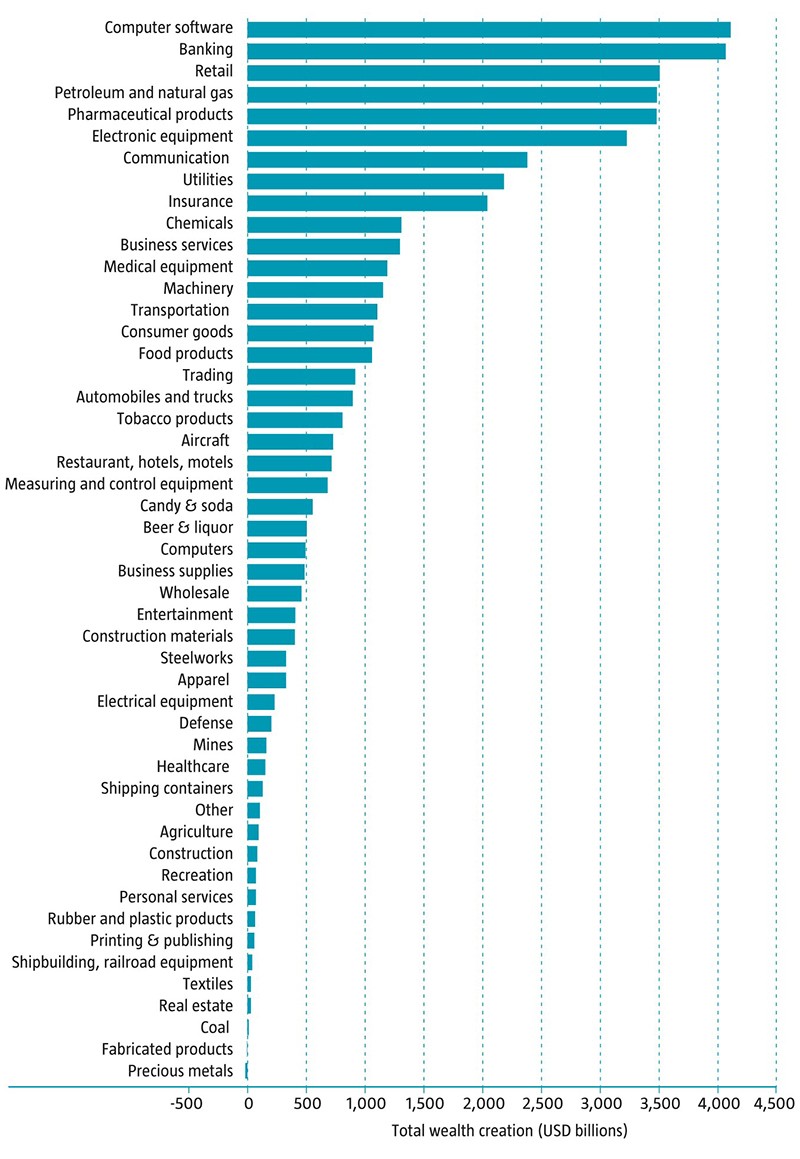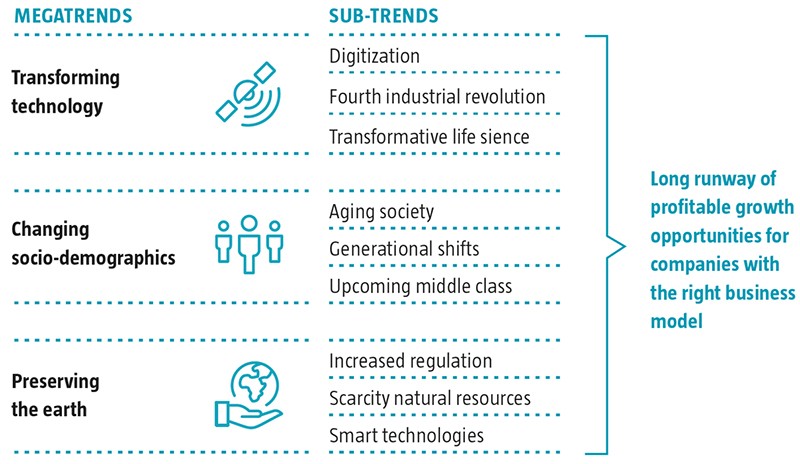Long-term investors might be surprised to find that a typical stock listed in the US from 1926 to 2019 had a buy-and-hold return of -2.8% over its entire lifetime. In an international context, from 1990 to 2018 the typical buy-and-hold return of a stock was -14.9%. This means that if an investor had picked a stock randomly, the most likely outcome would have been a loss of capital.
How is it possible then that the typical stock has a negative return but the average return of the market is 8% over the last 100 years? This discrepancy exists because the distribution of equity returns is skewed. Stock market returns are positive and higher than the return of the typical stock thanks to a relatively small group of stocks producing exceptional returns.
Exactly how exceptional was recently shown in a study by Professor Hendrik Bessembinder from Arizona State University, who calculated that just 4% of companies listed in the US were responsible for all wealth creation in the past 90 years. This shows that indiscriminate stock picking has very little chance of success. Investors need to find ways to improve theirs odds of selecting those companies that are not typical and belong to the small group of winning stocks.
We believe the concept of unanticipated economic profit, embedded in a trends-focused investment process, significantly improves these odds. Markets are largely efficient and reflect the aggregate expectations of all participants in the pricing of equities. Only when reality consistently exceeds or undershoots these expectations can we expect to see extraordinary long-term equity returns. Unanticipated economic profit is therefore crucial to finding the winners.
The small group of stocks that have created the majority of the wealth includes household names such as Apple, Microsoft and Amazon. Outside the US, stocks that have produced a disproportional amount of wealth are Tencent, Nestlé and Samsung.
At the industry level, we observe that relative profitability tends to remain steady over long intervals for most industries. Prosperous industries stay prosperous and poor industries stay poor. The emergence of new trends or disruptive innovations might cause long-term tail or headwinds for industries. In technology, the rise of the internet brought tremendous success for streaming services, and sounded the knell for physical video rental stores such as Blockbuster.
Greater disparities emerge by going back further, using the timeframe of 1926-2019. The software industry created USD 4.1 trillion in wealth for investors since its birth in the 1960s until now. On the other hand, the precious metals industry destroyed USD 17 billion in wealth. The contributions made by different industries is shown in the graphic below:
Figure 1: Wealth creation by industry in the United States from 1926-2019

Industries’ fortunes are influenced by global trends driven by changes in socio-demographics, policy and technology. Socio-demographic change relates to slow-moving developments in society, such as aging. Policy-driven change encompasses new laws such as the banking regulation that followed the financial crisis. Technological change relates to innovation such as that caused by digitalization.
Trends can cause industries to remain attractive by providing a long-term tailwind of growth, but can also destroy them when their products become obsolete. Trends can also positively influence the fortunes of an industry by facilitating new business models. Our contention is that long-term trends are an important underlying force driving the process of wealth creation or destruction.
A good example of this is the steel industry, which from 1945 to 1960 went through a wealth-creating period. Global demand for steel was high due to rapid population growth and the rebuilding of a war-torn world, while supply was limited as many steel mills had been destroyed. However, from 1960 through 2000, demand and supply were more in balance and wealth creation in the steel industry was stagnant. The industry experienced a brief period of wealth creation from 2000 to 2010 due to the rapid economic expansion of China but has since stagnated again.
The composition of the top wealth creators has also changed dramatically. In the pre-internet era, vertically integrated capital-intensive businesses dominated the stock market. However, with the advent of the internet and adoption of the smartphone, a new class of businesses has emerged as the main driver of wealth creation in equities. This is shown in the tables below.
Table 1: Top wealth creators before 1995: predominantly rely on tangible assets

Table 2: Top wealth creators from 1995 onwards: predominantly rely on intangible assets

We therefore believe that by understanding long-term secular trends, investors can improve their odds of finding the Apple’s and avoiding the Blockbuster’s. We have identified three megatrends that will shape the future and are likely the place where we can find the winners of tomorrow: transforming technology, changing socio-demographics and preserving the earth.
Figure 2: Three megatrends are shaping the world

We expect our three megatrends to impact several industries disproportionally in the coming years or even decades. For example, as a ‘transforming technology’ sub-trend, digital innovation is likely to impact the entire business world, and especially finance, banking and retail.
Another example comes from the ‘changing socio-demographics’ trend. With an aging population and more awareness for healthy living, the pharmaceutical, medical equipment and food products industries are likely to be impacted.
Regarding ‘preserving the earth’, the collective effort of governments, companies and consumers to slow down or stop global warming is likely to impact the petroleum, utilities and transportation industries.
In all, we believe exposure to industries and companies that are able to create substantial economic profit from megatrends is a valuable addition to investors’ portfolios.
This article is an excerpt of a special topic in our five-year outlook.